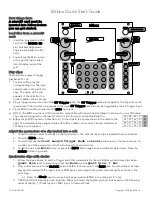
www.beast-tek.com
Dirty Glitch Assembly Manual
| 25
Step 9
Carefully turn the panel over and solder all of the controls into place. Pay special attention when
soldering the SPST switches as applying too much solder can cause a short circuit between the switch
body and the PCB.
Step 10
Take five of the cut component leads and insert them into ground pads on the PCB. Feed them into the
ground pin on the jacks solder into place and trim excess.




































